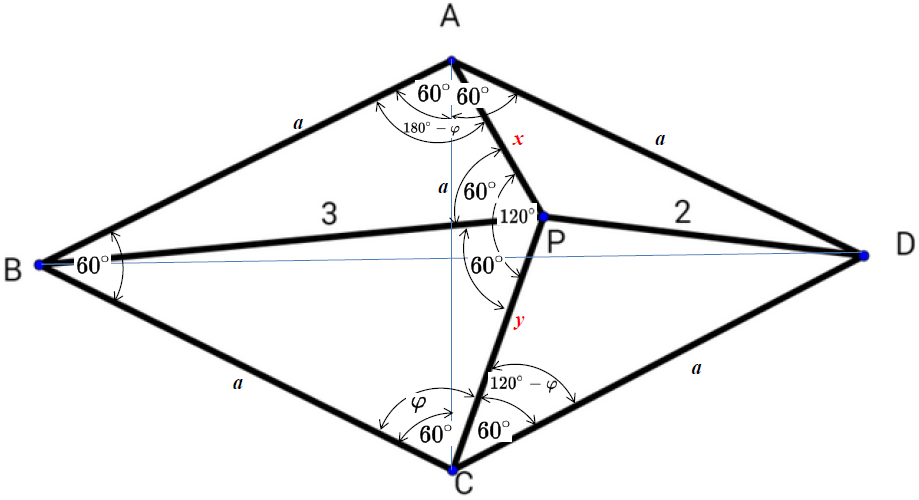ABCD is a rhombus with ∠B=60∘, ∠APC=120∘, BP=3 and PD=2.
Find the difference between the lengths of AP and PC.

\(\text{LET $AC=a\qquad$ (equilateral triangle) $ABC$} \\ \text{LET $BD=f$} \\ \text{LET $AP=x$} \\ \text{LET $PC=y$} \\ \text{LET $\angle PCA = \varphi-60^\circ$} \\ \text{LET $\angle CAP = 180^\circ-\varphi$}\)
cos-rule:
\(\begin{array}{|rcll|} \hline \text{In $\triangle ABD$} \\ \cos(120^\circ)=-\frac{1}{2} \\ \hline f^2 &=&a^2+a^2-2aa\cos(120^\circ) \\ f^2 &=& 2a^2(1-\cos(120^\circ)) \\ f^2 &=& 2a^2(1+\dfrac{1}{2}) \\ \ldots \\ \mathbf{f} &=& \mathbf{a\sqrt{3}} \\ \hline \end{array} \begin{array}{|rcll|} \hline \text{In $\triangle ACP$} \\ \cos(120^\circ)=-\frac{1}{2} \\ \hline a^2 &=&x^2+y^2-2xy\cos(120^\circ) \\ \mathbf{a^2} &=& \mathbf{x^2+y^2+xy} \\ \hline \end{array}\)
\(\begin{array}{|rcll|} \hline \dfrac{\sin(\varphi)}{3} &=& \dfrac{\sin(\angle BPC)}{a} \\\\ \dfrac{180^\circ-\sin(\varphi)}{3} &=& \dfrac{\sin(\angle BPA)}{a} \\ \dfrac{\sin(\varphi)}{3} &=& \dfrac{\sin(\angle BPA)}{a} \\\\ \hline \dfrac{\sin(\varphi)}{3} = \dfrac{\sin(\angle BPC)}{a} &=& \dfrac{\sin(\angle BPA)}{a} \\ \dfrac{sin(\angle BPC)}{a} &=& \dfrac{\sin(\angle BPA)}{a} \\\\ \angle BPC &=& \angle BPA \quad | \quad \angle BPC+\angle BPA=120^\circ \\ \angle BPC &=& \angle BPA = \dfrac{120^\circ}{2} \\ \mathbf{\angle BPC} &=& \mathbf{\angle BPA = 60^\circ } \\ \hline \end{array}\)
Formula:

\(\begin{array}{|rcll|} \hline \text{In $\triangle APC$} \\ \hline \dfrac{y-x}{a} &=& \dfrac{ \sin\left( \dfrac{(120^\circ-\varphi)-(\varphi-60^\circ) } {2} \right) } { \cos\left(\dfrac{120^\circ}{2}\right) } \\\\ \dfrac{y-x}{a} &=& \dfrac{ \sin\left( \dfrac{180^\circ-2\varphi } {2} \right) } { \cos(60^\circ) } \\\\ \dfrac{y-x}{a} &=& \dfrac{ \sin(90^\circ-\varphi ) } { \cos(60^\circ) } \\\\ \dfrac{y-x}{a} &=& \dfrac{ \cos(\varphi) } { \cos(60^\circ) } \quad | \quad \cos(60^\circ ) = \frac{1}{2} \\\\ \dfrac{y-x}{a} &=& 2\cos(\varphi) \\\\ \mathbf{y-x} &=& \mathbf{2a\cos(\varphi)} \\ \hline \end{array}\)
\(\begin{array}{|rcll|} \hline \text{In $\triangle ABP$} \\ \cos(60^\circ)=\frac{1}{2} \\ \hline a^2 &=& x^2+3^2-2*3x\cos(60^\circ) \\ \mathbf{a^2} &=& \mathbf{x^2+9-3x} \qquad (1) \\ \hline \end{array} \begin{array}{|rcll|} \hline \text{In $\triangle BCP$} \\ \cos(60^\circ)=\frac{1}{2} \\ \hline a^2 &=& y^2+3^2-2*3y\cos(60^\circ) \\ \mathbf{a^2} &=& \mathbf{y^2+9-3y} \qquad (2) \\ \hline \end{array} \)
\(\begin{array}{|lrcll|} \hline (1)-(2): & 0 &=& x^2+9-3x-(y^2+9-3y) \\ & 0 &=& x^2+9-3x-y^2-9+3y \\ & 0 &=& x^2-y^2-3x+3y \\ & 0 &=& (x-y)(x+y)-3(x-y) \\ & 3(x-y) &=& (x-y)(x+y) \quad | \quad :(x-y) \qquad (x-y) \ne 0 ! \qquad x\ne y \\ & 3 &=& x+y \\ & \mathbf{x+y} &=& \mathbf{3} \\ \hline \end{array}\)
cos-rule:
\(\begin{array}{|rcll|} \hline \text{In $\triangle CDP$} \\ \cos(120^\circ)=-\frac{1}{2} \\ \sin(120^\circ)=\frac{\sqrt{3}}{2} \\ \sin(60^\circ)=\frac{\sqrt{3}}{2} \\ \hline 2^2&=& y^2+a^2-2ay\cos(120^\circ-\varphi) \\ 2ay\cos(120^\circ-\varphi) &=& y^2+a^2 -4 \\ \cos(120^\circ-\varphi) &=& \dfrac{y^2+a^2 -4} {2ay} \\ \cos(120^\circ)\cos(\varphi)+\sin(120^\circ)\sin(\varphi) &=& \dfrac{y^2+a^2 -4} {2ay} \\ -\dfrac{\cos(\varphi)}{2}+\dfrac{\sqrt{3}}{2}\sin(\varphi) &=& \dfrac{y^2+a^2 -4} {2ay} \\ && \text{In $\triangle BCP$}:\\ && \boxed{\dfrac{\sin(\varphi)}{3}= \dfrac{\sin(60^\circ)}{a} \\ \sin(\varphi) = \dfrac{3}{a}*\dfrac{\sqrt{3}}{2} } \\ -\dfrac{\cos(\varphi)}{2}+\dfrac{\sqrt{3}}{2}*\dfrac{3}{a}*\dfrac{\sqrt{3}}{2} &=& \dfrac{y^2+a^2 -4} {2ay} \\ \dfrac{9}{4a}-\dfrac{\cos(\varphi)}{2} &=& \dfrac{y^2+a^2 -4} {2ay} \\ \dfrac{9}{2a}-\cos(\varphi) &=& \dfrac{y^2+a^2 -4} {ay} \\ \mathbf{\cos(\varphi)} &=& \mathbf{\dfrac{9}{2a} - \dfrac{y^2+a^2 -4} {ay}} \\ \hline \end{array}\)
\(\begin{array}{|rcll|} \hline \mathbf{\cos(\varphi)} &=& \mathbf{\dfrac{9}{2a} - \dfrac{y^2+a^2 -4} {ay}} \\ \hline \mathbf{y-x} &=& \mathbf{2a\cos(\varphi)} \\ y-x &=& 2a\left( \dfrac{9}{2a} - \dfrac{(y^2+a^2 -4)} {ay}*\dfrac{2}{2} \right) \\ y-x &=& \dfrac{2a}{2a}\left( 9 - \dfrac{2(y^2+a^2 -4)} {y} \right) \\ y-x &=& 9 - \dfrac{2(y^2+a^2 -4)} {y} \\ y-x &=& \dfrac{9y-2(y^2+a^2 -4)} {y} \\ y-x &=& \dfrac{9y-(2y^2+2a^2 -8)} {y} \quad | \quad a^2 = y^2+9-3y \\ y-x &=& \dfrac{9y-\Big(2y^2+2(y^2+9-3y) -8 \Big)} {y} \\ y-x &=& \dfrac{9y-(4y^2-6y+10) } {y} \\ y-x &=& \dfrac{15y-4y^2-10} {y} \\ y(y-x) &=& 15y-4y^2-10 \quad | \quad \mathbf{x+y=3}\ \text{or}\ x=3-y \\ y\Big(y-(3-y)\Big) &=& 15y-4y^2-10 \\ y(2y-3) &=& 15y-4y^2-10 \\ 2y^2-3y &=& 15y-4y^2-10 \\\\ \mathbf{6y^2 -18y +10} &=& \mathbf{0} \\ y &=& \dfrac{18\pm \sqrt{18^2-4*6*10}}{2*6} \\\\ y &=& \dfrac{18\pm \sqrt{84} } {12} \\\\ y &=& \dfrac{18+ \sqrt{84} }{12} \\\\ y &=& \dfrac{18+ \sqrt{84} }{12} \\\\ \mathbf{y} &=& \mathbf{2.26376261583} \\\\ x &=& 3-y \\ x &=& 3- 2.26376261583 \\ \mathbf{x} &=& \mathbf{0.73623738417} \\\\ x-y &=& 0.73623738417 - 2.26376261583 \\ \mathbf{x-y} &=& \mathbf{-1.52752523165} \\ \hline \end{array}\)
The difference between the lengths of AP and PC is \(\mathbf{-1.52752523165}\)
